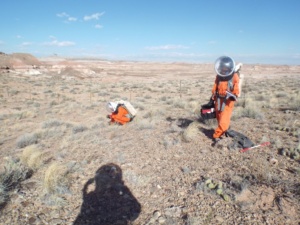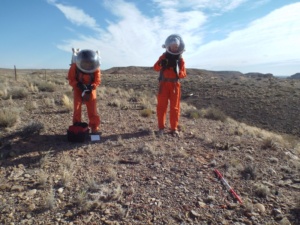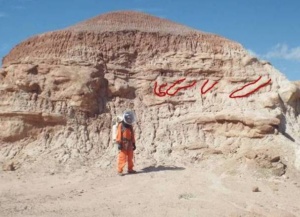EVA Narrative – October 17th
A DIFFERENT TYPE OF EVA – AND WHAT CAME OF IT.
Jon Clarke
Looking for hypoliths
“Extra-vehicular activity” covers of a multitude of tasks, on simulated space missions as well as actual ones. Some are engineering focussed – pumping water, refuelling, carry out minor repairs. Others are scouting, like the one to Skyline Rim last week. Still others are focused on very specific science tasks. Today we dedicated an entire EVA to one scientific goal, documenting hypoliths in the field.
What’s a hypolith you say? I am glad you asked! Hypoliths are colonies of photosynthetic organisms that live under translucent rocks, usually in desert or alpine settings. These micro-environments trap moisture and offer shelter from temperature extremes and high ultra-violet levels, while still allowing enough light through for them to photosynthesise. These types of micro-environments point to the kind of location where life might exist, or once existed, on Mars.
Looking for hypoliths at a different site
Today we carried out the first stage of study, characterising their occurrence in the field. In field ecology, as with geology, context is everything. This meant examining and counting every quartz pebble in a old terrace of the Fremont river within a specific area. The recorded the orientation of each pebbles and the number we were colonised by hypoliths. Slow, painstaking work. Anushree, our biologist, and her support team of biologists in the broader mission, will characterise these samples in the lab in the near future.
Of course we did not just look at hypoliths. The location had lichens growing on many different rock types, so we sampled these as well. As geologist, I also looked at the ancient flow directions in the inverted channels in outcrops as we made our way back.
Probable Jurassic reptile burrows in side of small mesa of Morrison Formation
Probable Jurassic reptile burrows outlined in red
At one of these outcrops, one I had past many times, something caught my eye. The light angle was just right, and there, on the side of a small mesa, were angled burrows up to 1.5 m long and 20-30 cm across. Studies of the trace fossils of the Jurassic Morrison Formation by Stephen Hasiotis of the University of Kansas indicate that these burrows were dug by medium sized reptiles such as crocodiles or sphenodonts. Once again, this illustrates the importance of being able to revisit sites, because some features only become evident to the observer are multiple visits.







